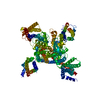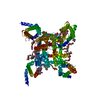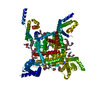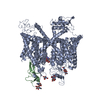+ Open data
Open data
- Basic information
Basic information
| Entry | Database: PDB / ID: 6lqa | ||||||
|---|---|---|---|---|---|---|---|
| Title | voltage-gated sodium channel Nav1.5 with quinidine | ||||||
 Components Components | Sodium channel protein type 5 subunit alpha | ||||||
 Keywords Keywords | TRANSPORT PROTEIN / membrane protein / Voltage-gated sodium channel | ||||||
| Function / homology |  Function and homology information Function and homology informationvoltage-gated sodium channel activity involved in AV node cell action potential / voltage-gated sodium channel activity involved in bundle of His cell action potential / voltage-gated sodium channel activity involved in Purkinje myocyte action potential / voltage-gated sodium channel activity involved in SA node cell action potential / bundle of His cell action potential / regulation of ventricular cardiac muscle cell membrane depolarization / AV node cell action potential / SA node cell action potential / AV node cell to bundle of His cell communication / membrane depolarization during SA node cell action potential ...voltage-gated sodium channel activity involved in AV node cell action potential / voltage-gated sodium channel activity involved in bundle of His cell action potential / voltage-gated sodium channel activity involved in Purkinje myocyte action potential / voltage-gated sodium channel activity involved in SA node cell action potential / bundle of His cell action potential / regulation of ventricular cardiac muscle cell membrane depolarization / AV node cell action potential / SA node cell action potential / AV node cell to bundle of His cell communication / membrane depolarization during SA node cell action potential / response to denervation involved in regulation of muscle adaptation / membrane depolarization during atrial cardiac muscle cell action potential / cardiac ventricle development / regulation of atrial cardiac muscle cell membrane repolarization / voltage-gated sodium channel activity involved in cardiac muscle cell action potential / brainstem development / membrane depolarization during AV node cell action potential / regulation of atrial cardiac muscle cell membrane depolarization / membrane depolarization during bundle of His cell action potential / positive regulation of action potential / membrane depolarization during Purkinje myocyte cell action potential / atrial cardiac muscle cell action potential / cardiac conduction system development / telencephalon development / membrane depolarization during cardiac muscle cell action potential / membrane depolarization during action potential / positive regulation of sodium ion transport / regulation of sodium ion transmembrane transport / ventricular cardiac muscle cell action potential / regulation of ventricular cardiac muscle cell membrane repolarization / cardiac muscle cell action potential involved in contraction / voltage-gated sodium channel complex / regulation of cardiac muscle cell contraction / Interaction between L1 and Ankyrins / ankyrin binding / voltage-gated sodium channel activity / sodium ion transport / nitric-oxide synthase binding / odontogenesis of dentin-containing tooth / Phase 0 - rapid depolarisation / regulation of heart rate by cardiac conduction / fibroblast growth factor binding / intercalated disc / lateral plasma membrane / membrane depolarization / cardiac muscle contraction / T-tubule / regulation of heart rate / cellular response to calcium ion / sodium ion transmembrane transport / cerebellum development / positive regulation of epithelial cell proliferation / sarcolemma / caveola / Z disc / scaffold protein binding / transmembrane transporter binding / calmodulin binding / protein domain specific binding / ubiquitin protein ligase binding / protein kinase binding / nucleolus / perinuclear region of cytoplasm / enzyme binding / cell surface / endoplasmic reticulum / nucleoplasm / membrane / plasma membrane Similarity search - Function | ||||||
| Biological species |  Homo sapiens (human) Homo sapiens (human) | ||||||
| Method | ELECTRON MICROSCOPY / single particle reconstruction / cryo EM / Resolution: 3.3 Å | ||||||
 Authors Authors | Yan, N. / Li, Z. / Pan, X. / Huang, G. | ||||||
| Funding support |  China, 1items China, 1items
| ||||||
 Citation Citation |  Journal: Angew Chem Int Ed Engl / Year: 2021 Journal: Angew Chem Int Ed Engl / Year: 2021Title: Structural Basis for Pore Blockade of the Human Cardiac Sodium Channel Na 1.5 by the Antiarrhythmic Drug Quinidine*. Authors: Zhangqiang Li / Xueqin Jin / Tong Wu / Gaoxingyu Huang / Kun Wu / Jianlin Lei / Xiaojing Pan / Nieng Yan /   Abstract: Na 1.5, the primary voltage-gated Na (Na ) channel in heart, is a major target for class I antiarrhythmic agents. Here we present the cryo-EM structure of full-length human Na 1.5 bound to quinidine, ...Na 1.5, the primary voltage-gated Na (Na ) channel in heart, is a major target for class I antiarrhythmic agents. Here we present the cryo-EM structure of full-length human Na 1.5 bound to quinidine, a class Ia antiarrhythmic drug, at 3.3 Å resolution. Quinidine is positioned right beneath the selectivity filter in the pore domain and coordinated by residues from repeats I, III, and IV. Pore blockade by quinidine is achieved through both direct obstruction of the ion permeation path and induced rotation of an invariant Tyr residue that tightens the intracellular gate. Structural comparison with a truncated rat Na 1.5 in the presence of flecainide, a class Ic agent, reveals distinct binding poses for the two antiarrhythmics within the pore domain. Our work reported here, along with previous studies, reveals the molecular basis for the mechanism of action of class I antiarrhythmic drugs. | ||||||
| History |
|
- Structure visualization
Structure visualization
| Movie |
 Movie viewer Movie viewer |
|---|---|
| Structure viewer | Molecule:  Molmil Molmil Jmol/JSmol Jmol/JSmol |
- Downloads & links
Downloads & links
- Download
Download
| PDBx/mmCIF format |  6lqa.cif.gz 6lqa.cif.gz | 241.1 KB | Display |  PDBx/mmCIF format PDBx/mmCIF format |
|---|---|---|---|---|
| PDB format |  pdb6lqa.ent.gz pdb6lqa.ent.gz | 176.9 KB | Display |  PDB format PDB format |
| PDBx/mmJSON format |  6lqa.json.gz 6lqa.json.gz | Tree view |  PDBx/mmJSON format PDBx/mmJSON format | |
| Others |  Other downloads Other downloads |
-Validation report
| Summary document |  6lqa_validation.pdf.gz 6lqa_validation.pdf.gz | 988.8 KB | Display |  wwPDB validaton report wwPDB validaton report |
|---|---|---|---|---|
| Full document |  6lqa_full_validation.pdf.gz 6lqa_full_validation.pdf.gz | 1019.8 KB | Display | |
| Data in XML |  6lqa_validation.xml.gz 6lqa_validation.xml.gz | 37.6 KB | Display | |
| Data in CIF |  6lqa_validation.cif.gz 6lqa_validation.cif.gz | 57.6 KB | Display | |
| Arichive directory |  https://data.pdbj.org/pub/pdb/validation_reports/lq/6lqa https://data.pdbj.org/pub/pdb/validation_reports/lq/6lqa ftp://data.pdbj.org/pub/pdb/validation_reports/lq/6lqa ftp://data.pdbj.org/pub/pdb/validation_reports/lq/6lqa | HTTPS FTP |
-Related structure data
| Related structure data |  0942MC M: map data used to model this data C: citing same article ( |
|---|---|
| Similar structure data |
- Links
Links
- Assembly
Assembly
| Deposited unit | 
|
|---|---|
| 1 |
|
- Components
Components
| #1: Protein | Mass: 231743.938 Da / Num. of mol.: 1 Source method: isolated from a genetically manipulated source Source: (gene. exp.)  Homo sapiens (human) / Gene: SCN5A / Production host: Homo sapiens (human) / Gene: SCN5A / Production host:  Homo sapiens (human) / References: UniProt: Q14524 Homo sapiens (human) / References: UniProt: Q14524 | ||||||
|---|---|---|---|---|---|---|---|
| #2: Sugar | ChemComp-NAG / #3: Chemical | ChemComp-QDN / | Has ligand of interest | Y | Has protein modification | Y | |
-Experimental details
-Experiment
| Experiment | Method: ELECTRON MICROSCOPY |
|---|---|
| EM experiment | Aggregation state: PARTICLE / 3D reconstruction method: single particle reconstruction |
- Sample preparation
Sample preparation
| Component | Name: Voltage-gated sodium channel with drug / Type: COMPLEX / Entity ID: #1 / Source: RECOMBINANT |
|---|---|
| Source (natural) | Organism:  Homo sapiens (human) Homo sapiens (human) |
| Source (recombinant) | Organism:  Homo sapiens (human) Homo sapiens (human) |
| Buffer solution | pH: 7.5 |
| Specimen | Embedding applied: NO / Shadowing applied: NO / Staining applied: NO / Vitrification applied: YES |
| Specimen support | Grid material: GOLD / Grid mesh size: 300 divisions/in. / Grid type: Quantifoil R1.2/1.3 |
| Vitrification | Cryogen name: ETHANE |
- Electron microscopy imaging
Electron microscopy imaging
| Experimental equipment |  Model: Titan Krios / Image courtesy: FEI Company |
|---|---|
| Microscopy | Model: FEI TITAN KRIOS |
| Electron gun | Electron source:  FIELD EMISSION GUN / Accelerating voltage: 300 kV / Illumination mode: FLOOD BEAM FIELD EMISSION GUN / Accelerating voltage: 300 kV / Illumination mode: FLOOD BEAM |
| Electron lens | Mode: BRIGHT FIELD |
| Image recording | Electron dose: 48 e/Å2 / Film or detector model: GATAN K2 SUMMIT (4k x 4k) |
- Processing
Processing
| CTF correction | Type: PHASE FLIPPING ONLY |
|---|---|
| 3D reconstruction | Resolution: 3.3 Å / Resolution method: FSC 0.143 CUT-OFF / Num. of particles: 124954 / Symmetry type: POINT |
 Movie
Movie Controller
Controller










 PDBj
PDBj







